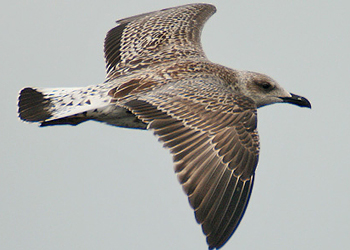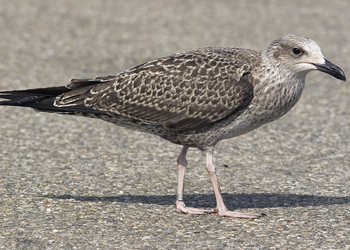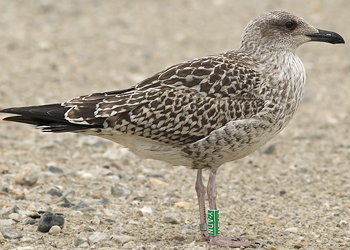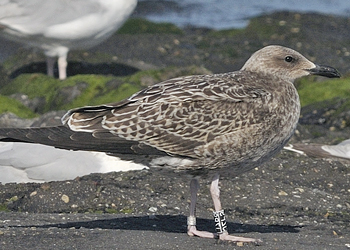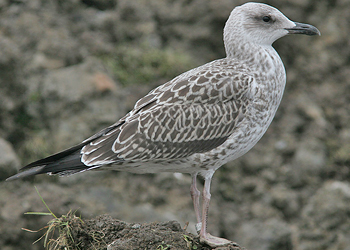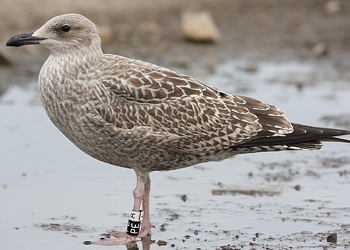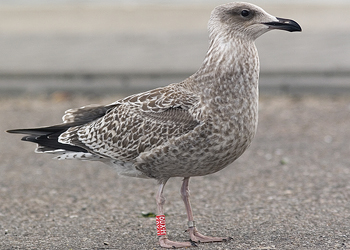 nominate Lesser Black-backed Gull (L. f. fuscus)
nominate Lesser Black-backed Gull (L. f. fuscus)
(last update:
Amir Ben Dov (Israel)
Hannu Koskinen (Finland)
Mars Muusse (the Netherlands)
fuscus 1cy July
fuscus 1cy Aug
fuscus 1cy Sept
fuscus 1cy Oct
fuscus 1cy Nov
fuscus 1cy Dec
fuscus 2cy Jan
fuscus 2cy Feb
fuscus 2cy March
fuscus 2cy April
fuscus 2cy May
fuscus 2cy June
fuscus 2cy July
fuscus 2cy Aug
fuscus 2cy Sept
fuscus 2cy Oct
fuscus 2cy Nov
fuscus 2cy Dec
fuscus 3cy Jan
fuscus 3cy Feb
fuscus 3cy March
fuscus 3cy April
fuscus 3cy May
fuscus 3cy June
fuscus 3cy July
fuscus 3cy August
fuscus 3cy Sept
fuscus 3cy October
fuscus 3cy Nov
fuscus 3cy Dec
fuscus 4cy Jan
fuscus 4cy Feb
fuscus 4cy March
fuscus 4cy April
fuscus 4cy May
fuscus 4cy June
fuscus 4cy July
fuscus 4cy Aug
fuscus 4cy Sept
fuscus 4cy Oct
fuscus 4cy Nov
fuscus 4cy Dec
fuscus ad Jan
fuscus ad Feb
fuscus ad March
fuscus ad April
fuscus ad May
fuscus ad June
fuscus ad July
fuscus ad Aug
fuscus unringed Aug
fuscus ad Sept
fuscus ad Oct
fuscus ad Nov
fuscus ad Dec
Typical juvenile nominate fuscus are hard to describe as the variation in colour and shape is extensive, but on average a few points may indicate specific identification. Note however that single individuals from graellsii, intermedius and fuscus are almost impossible to tell apart as there exists a large overlap. For comparison, a juvenile intermedius from Götenborg, SW Sweden is added at the bottom. Images of ringed graellsii and unidentified graellsii / intermedius can be found in the Lesser Black-backed Gull sections of August, September, October and November-December.
Colour and contrast
As early as August, many nominate fuscus are remarkable contrastingly patterned. The centres of the scapulars and wing-coverts are very dark brown, almost blackish brown. The fringes are very pale and quickly lose the brown hue characteristically found in very fresh fledged juveniles. The fringes are rather pale, almost white. The average graellsii and intermedius in the Dutch colonies (Maasvlakte, near Rotterdam) seem to be warmer coloured, although individuals with very pale fringes and dark brown centred scapulars can be found in Dutch colonies as well (see e.g. there). On the other hand, individuals with warm brown fringes can be found in Finland, as the first image shows. This bird was still begging at a parent at the Tampere landfill and typically these warm brown individuals may turn more contrastingly patterned once the fringes bleach after several weeks. Some juveniles remain warmer brown during the month of September. Nevertheless, the average picture hold with nominate fuscus more contrastingly patterned and the graellsii / intermedius juveniles on average warmer brown, especially on the fringes of scapulars and wing-coverts, but also on the nape, ear-coverts and belly.
Jonsson, in his article in Birding World volume 11 no 8 (1998) estimates a 10% of juvenile fuscus to show very pale fringes "the light areas sometimes appear 'over-exposed' so that the belly and head can be almost white" and he classifies these juveniles as 'light morph birds'. The other 90% belong to the average group and some appear dark brown, almost lacking any pale fringes in the greater coverts.
Shape and expression
As with the adult nominate fuscus, juveniles appear more delicately built than their western relatives intermedius and surely graellsii; fuscus being small, long-winged and thin-billed. Especially the obvious P10 projection, well over P9, attracts attention but dealing with a single bird, there may be no particular characteristic to identify a juvenile fuscus from intermedius.
Post-juvenile moult in juvenile fuscus
As can be seen in the pictures, most birds show a complete juvenile plumage by early August. Numbers are too low to draw any conclusions about the post-juvenile moult, but at least a few birds started the post-juvenile moult as early as August 07 at the Tampere landfill, in SW Finland (see e.g. this bird and CHR5). Jonsson (in his article in Birding World) mentions that post-juvenile moult may start in August in some individuals. On the other hand, juvenile fuscus may arrive at the African wintering grounds, still in complete juvenile plumage by late September to December according to Jonsson (November 1cy, Israel). Part of the explanation could be related to the large breeding area in Scandinavia, from the southern latitudes, Baltic region through central Norway all the way north to northern Norway and east to the White Sea.
Jonsson observed juvenile fuscus mainly at Gotland SW Sweden, where most birds are growing second generation scapulars and mantle feathers by mid September. New scapulars may show a distinct anchor shape, as can be found commonly in graellsii and intermedius (see again the sections of September and October, other juvenile fuscus replace the juvenile feathers for plain dark slate-grey feathers with a broad blackish wedge-shaped centre. Such plain patterns can only rarely be found in intermedius by early autumn. Below, tables are presented to show the post-juvenile moult timing of Dutch intergrades in colonies in SW Netherlands.
Tables
| start of post-juvenile moult: in (still begging) juvenile LBBG near the Maasvlakte colonies (<300 meters). Samples from July 13 2002 (with over 500 juveniles at single sites). In this sample the number of shed scapulars has beens scored, normally in the lower upper scapular region (see Section Bird Topography for explanations). In the field, it's hard to establish whether mantle feathers have been shed (although fully grown second generation mantle feathers may be recognized). When scapulars are missing this implicitly means new second generation scapulars are growing in, as the old feathers are 'pushed out' by the new ones. Note that fledged juveniles may show odd moult patterns, but in any case growing p9 and p10 seems to to finish the complete juvenile moult. In the mean time, with p9 and p10 growing, odd birds may still miss the outer greater coverts (from #10 outwards), or may miss median coverts (normally #3-6), may miss the inner greater coverts (#1-5), may miss the central tail-feathers (R1) or may miss feathers in the lowest row of lower scapulars. |
||
| score | Dintelhaven | Papegaaienbek |
| compl juv | 40 | 47 |
| worn juv | 5 | 4 |
| 1-5 miss | 3 | - |
| 6-10 miss | - | - |
| 11-20 miss | - | - |
| n: | 48 | 51 |
| compl juv: complete juvenile plumage in recently fledged juveniles, so no wear in the fringes and in some birds p8 is still the longest primary, with p9 and p10 growing (by this time many birds leave the nest site and disperse to near sandy beaches. worn juv: juvenile plumage with worn fringes in the (rear) wing-coverts and the scapulars and mantle feathers. The upper two tertials may show wear as well. In almost all birds, p10 is fully grown now. 1-5 miss: 1-5 scapulars have been shed. 6-10 miss: 6-10 scapulars have been shed. 11-20 miss: 11-20 scapulars have been shed. New feathers are growing in. Dintelhaven: score from location Dintelhaven - Maasvlakte, the Netherlands (51.57N,04.03E). See Maasvlakte map. Papegaaienbek: score from location Papegaaienbek - Maasvlakte, the Netherlands (51.57N,04.03E). See Maasvlakte map. |
||
| new and/or missing mantle, scapulars, coverts and tertials: in (still begging) juvenile LBBG in the Maasvlakte colony 16.08.2001 (n=32). |
|||
| mantle | scaps | covs/tertials | # |
| 0 | 0 | 0 | 4 |
| ? | 0 | 0 | 8 |
| 0 | 1-5 | 0 | 2 |
| ? | 1-5 | 0 | 7 |
| 0 | 6-10 | 0 | 2 |
| 1-5 | 1-5 | 0 | 1 |
| 1-5 | 1-5 | 1-5 | 3 |
| ? | 1-5 | 1-5 | 1 |
| 0 | 6-10 | 1-5 | 3 |
| ? | 6-10 | 1-5 | 1 |
| new and/or missing mantle, scapulars, coverts and tertials: in ringed Finnish juvenile fuscus in August at Tara dump, Tampere, Finland (n=21). |
|||
| mantle | scaps | covs/tertials | # |
| 0 | 0 | 0 | 10 |
| ? | 0 | 0 | 1 |
| 0 | 1-5 | 0 | 3 |
| 1-5 | 1-5 | 0 | 4 |
| 1-5 | 0 | 0 | 2 |
| 6-10 | 6-10 | 0 | 1 |
 Larus fuscus fuscus 1cy C4P8 July 30 2013, Tampere, Finland (61.33N 24.59E). Images: Hannu Koskinen.
Larus fuscus fuscus 1cy C4P8 July 30 2013, Tampere, Finland (61.33N 24.59E). Images: Hannu Koskinen. Larus fuscus fuscus 1cy C5P5 July 30 2013, Tampere, Finland (61.33N 24.59E). Images: Hannu Koskinen.
Larus fuscus fuscus 1cy C5P5 July 30 2013, Tampere, Finland (61.33N 24.59E). Images: Hannu Koskinen.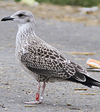 Larus fuscus fuscus 1cy C7H5 July 29 2013, Tampere, Finland (61.33N 24.59E). Images: Hannu Koskinen.
Larus fuscus fuscus 1cy C7H5 July 29 2013, Tampere, Finland (61.33N 24.59E). Images: Hannu Koskinen.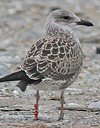 Larus fuscus fuscus 1cy C8H7 July 30 2013, Tampere, Finland (61.33N 24.59E). Images: Hannu Koskinen.
Larus fuscus fuscus 1cy C8H7 July 30 2013, Tampere, Finland (61.33N 24.59E). Images: Hannu Koskinen. Larus fuscus fuscus 1cy CXCU July 29 2013, Tampere, Finland (61.33N 24.59E). Images: Hannu Koskinen.
Larus fuscus fuscus 1cy CXCU July 29 2013, Tampere, Finland (61.33N 24.59E). Images: Hannu Koskinen. Larus fuscus fuscus 1cy, July 30 2013, Tampere, Finland (61.33N 24.59E). Images: Hannu Koskinen.
Larus fuscus fuscus 1cy, July 30 2013, Tampere, Finland (61.33N 24.59E). Images: Hannu Koskinen.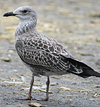 Larus fuscus fuscus 1cy, July 29 2013, Tampere, Finland (61.33N 24.59E). Images: Hannu Koskinen.
Larus fuscus fuscus 1cy, July 29 2013, Tampere, Finland (61.33N 24.59E). Images: Hannu Koskinen. Larus fuscus fuscus 1cy, July 30 2013, Tampere, Finland (61.33N 24.59E). Images: Hannu Koskinen.
Larus fuscus fuscus 1cy, July 30 2013, Tampere, Finland (61.33N 24.59E). Images: Hannu Koskinen. Larus fuscus fuscus 1cy, July 30 2013, Tampere, Finland (61.33N 24.59E). Images: Hannu Koskinen.
Larus fuscus fuscus 1cy, July 30 2013, Tampere, Finland (61.33N 24.59E). Images: Hannu Koskinen. Larus fuscus fuscus 1cy, July 30 2013, Tampere, Finland (61.33N 24.59E). Images: Hannu Koskinen.
Larus fuscus fuscus 1cy, July 30 2013, Tampere, Finland (61.33N 24.59E). Images: Hannu Koskinen. Larus fuscus fuscus 1cy, July 30 2013, Tampere, Finland (61.33N 24.59E). Images: Hannu Koskinen.
Larus fuscus fuscus 1cy, July 30 2013, Tampere, Finland (61.33N 24.59E). Images: Hannu Koskinen.


